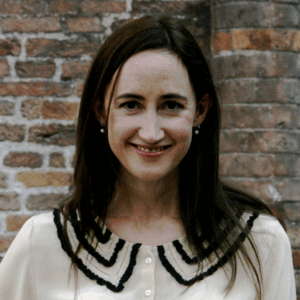
5 Books Making News This Week: Dystopias, Detectives, and Tricky Dick
Omar El Akkad, Leonardo Padura, and John A. Farrell
From 1984 to The Handmaid’s Tale and It Can’t Happen Here, we’re rereading the past these days. This week, a relatively recent gem from the Washington Post’s Carlos Lozada, whose July 30, 2015 review,“I just binge-read eight books by Donald Trump here’s what I learned,” helped him win the National Book Critics Circle Balakian award in criticism. His latest is a savvy analysis of the 2013 Mr. Putin: Operative in the Kremlin—a 500-page psychological profile of the Russian leader co-authored by Fiona Hill, the incoming senior director for Russia and Europe on Trump’s National Security Council staff. A dystopian first novel from a former Globe and Mail war correspondent who has seen 21st century conflicts firsthand, a novel about the author of Being There, yet another biography of Richard Nixon, a Cuban detective series expands its range, and novelist Valeria Luiselli’s urgent book on the U.S. immigration system.

Omar El Akkad, American War
American War posits a Second American Civil War (2074 and 2095) over oil, a consequence of climate change, in the latter part of the 21st century. The author of this dystopian first novel was born in Cairo, raised in Doha, Qatar, and is a former war correspondent for Canada’s Globe and Mail. Sarat Chestnut, the young girl at the center of the story, came to him fully formed, he tells NPR’s Lulu Garcia-Navarro. “At the start of the book she’s six years old,” he says, “and to me she’s sort of this very curious, trusting, defiant young girl whose chief attribute is this kind of rebellion against unknowing. She wants to know as much as possible. And the central arc of the book is essentially her life, and how her desire to know, her curiosity, is sort of used against her during this war.”
“I never intended American War to be a novel about America or war,” El Akkad writes in Quill and Quire. “It is a novel about the recursive nature of revenge, the way evil begets evil. To construct the world in which the story takes place, I took some of the defining wars of my lifetime—the Israeli-Palestinian conflict, the invasions of Afghanistan and Iraq, the strife that followed the Arab Spring—and recast elements of them as part of an American conflict. The intent was to show that all people, regardless of ethnicity or religion or culture, respond to injustice in much the same way—they are damaged by it the same way, made angry and bitter and vengeful the same way.”
Jeff VanderMeer (Los Angeles Times) calls American War “a worthy first novel, thought-provoking, earnest and mostly well-wrought. It is at its best depicting the lives of ordinary people caught up in terrible circumstances and how those ordinary people are, in the crosshairs of crisis, forever changed, and how some can become extraordinary or at least affect history.”
El Akkad “reported on the war in Afghanistan, the military tribunals at Guantánamo Bay and the Arab Spring,” notes Michiko Kakutani (New York Times). “His familiarity with the United States’ war on terror informs this novel on every level, from his shattering descriptions of the torture endured by one of his main characters to his bone-deep understanding of the costs of war on civilians, who suddenly find themselves living in combat zones or forced into refugee camps with no other future on the horizon.”
“Let’s hope this doesn’t turn out to be prophetic,” writes Rayyan Al-Shawaf (Boston Globe).
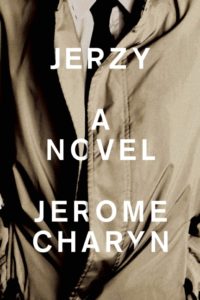
Jerome Charyn, Jerzy
After writing about Emily Dickinson, Joe DiMaggio and Abraham Lincoln, Charyn turned to Kosinski. “He was a shadow within a shadow within a shadow,” Charyn tells Stay Thirsty magazine. “That’s the nature of the Holocaust.” Kosinski, he adds, “looked like a painted bird, wrote like a painted bird, and died like one.”
Ruth Franklin (The New Yorker) gives context:
In a career spanning more than 50 years, Charyn has published 30 novels, including, in 2010, The Secret Life of Emily Dickinson, which narrates a fictional version of the poet’s life in her own voice—a literary license at which some readers took offense. This time, he has chosen a more circumspect approach, telling Kosinski’s story primarily from the perspectives of various characters who encounter him: Ian, Peter Sellers’s driver, who is tasked with persuading Kosinski to allow his boss to play the lead role in Being There; Svetlana Alliluyeva, Stalin’s daughter, who met Kosinski when they were briefly neighbors in Princeton; Kosinski’s first wife, here a petroleum-jelly heiress “cast out of the Social Register after her recent marriage to a Polish parvenu”; and a dominatrix who goes by the moniker Anna Karenina. Kosinski slips in and out of their fragmented narratives, a presence at once signally important and maddeningly elusive.
“Jerzy is a novel with a light touch that’s still capable of lifting heavy subjects,” notes Benjamin Markovits (New York Times Book Review). “Charyn knows what he wants to do and knows how to do it. His prose has some of the rapid-fire but carefully controlled energy of Thomas Pynchon’s early novella The Crying of Lot 49. Part of Charyn’s point is to make the real and the imagined sound equally implausible. You find yourself looking up some of the characters, some of the episodes, online: Can this be true? It isn’t always easy to tell.”
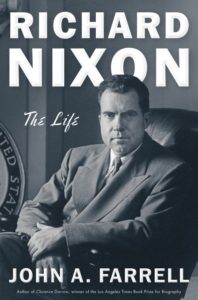
John A. Farrell, Richard Nixon: The Life
The Final Days, One Man Against the World, All the President’s Men, Nixon Agonistes. The list goes on. Another biography of Richard Nixon? Yes, and it’s ever so timely.
William Howell (San Francisco Chronicle) writes, “In his beautifully written and deeply insightful biography . . . Farrell, a former White House correspondent for the Boston Globe, offers a bracing portrait of a man untethered from principle and ideology, driven throughout his life to win at any cost and thereby palliate his deep-seated insecurities.”
“Farrell has written the best one-volume, cradle-to-grave biography that we could expect about such a famously elusive subject,” writes Aram Goudsouzian (Washington Post). “By employing recently released government documents and oral histories, he adds layers of understanding to a complex man and his dastardly decisions. Farrell avoids one conventional assumption: that Nixon was always Tricky Dick, a tortured schemer who mastered the dark arts of politics. He does follow the trail of liberal derision throughout Nixon’s life, but he sticks close to the man, depicting not only his anxieties and anger, but also his sincerity and self-discipline. That approach helps explain Nixon’s resonance in American politics over nearly three decades.”
Dale Singer (St. Louis Post-Dispatch) concludes:
. . . during Nixon’s first presidential run, when Eisenhower was asked at a news conference to name an important contribution his vice president had made to a major decision. “If you give me a week,” Ike replied, “I might think of one.”
That was the kind of snub that Nixon, the underdog from small-town Whittier, Calif., battled his entire career. In a biography that is more synthesis than revelation, more analysis than breaking news, Farrell puts the politician’s accomplishments and failures in context to give a good accounting of one of the most fascinating, enigmatic figures of 20th-century America.
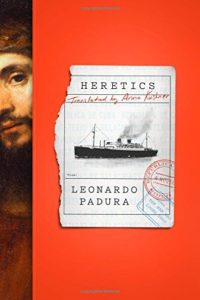
Leonardo Padura, Heretics, tr. Anna Kushner
Padura’s eighth novel featuring Cuban ex-cop Mario Conde (beginning with Havana Blue) is his most complicated yet (plus there’s a Rembrandt). Padura won the 2015 Premio Princesa de Asturias de las Letras (honorees include Richard Ford, John Banville, Margaret Atwood, Amos Oz, Doris Lessing).
Michael Orthofer (The Complete Review) writes:
Heretics is a long, elaborate novel . . . this eighth Conde-book is the most ambitious, and extends considerably beyond just the simple (or not so simple) local cases of the “Havana Quartet” et al. It is, arguably, three books in one—indeed, it is divided into four sections, and each of the first three (“Book of Daniel,” “Book of Elias,” “Book of Judith”) is long enough—and sufficiently rounded off—that it could pass for a stand-alone novel(la). And the middle one doesn’t even feature Conde at all.
Translators don’t get enough love, notes Jason Sheehan (NPR). “Kushner, working here with one of the most beloved writers in modern Cuba, is dealing both with a man who has a serious way with words and a massive, sprawling door-stopper of a novel that takes one of the most exhausted tropes in upper-crust detective fiction (the missing painting McGuffin), crosses it with a historical fiction (stretching all the way back to the 17th century in places), mixes in the tale of a mysterious missing emo girl and, in the process, creates something that feels like a grungy, beautiful gutter epic. Something rum-soaked and bloody. Dangerous and funny. Chandler in the tropics, if Chandler had a sense of humor and a PhD in art history and Diaspora studies.”
Maureen Corrigan (NPR) concludes:
Cloaked within familiar narrative conventions, Padura’s ingenious novel is something of a heretic itself: by turns playful, dark, and moving, it traces the great psychic costs—and rewards—that come from nestling so deeply into dogma that nothing is permitted to trigger doubt. This was the great theme of classic works of the fascist and communist 20th century like, of course, Orwell’s 1984. We were supposed to have awoken from those nightmares. But, as Padura reminds us, perhaps we haven’t.
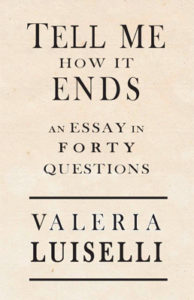
Valeria Luiselli, Tell Me How it Ends
Award-winning Mexican author Luiselli’s new nonfiction book about her time as a volunteer interpreter in U.S. immigration court started out as an essay in Freeman’s magazine, then was expanded into a Spanish-language book published by Sexto Piso. “Latin America is always covered in the media as a barbaric separate region that the U.S. should protect itself from, so the barbarism doesn’t flood in,” Luiselli tells Wendy Smith (Newsday). “They don’t mention that American money goes to criminal governments in the region, the arms and guns that go back and forth, the drugs that are consumed here. I do hope that the book can open people’s eyes to those facts. There’s no use pointing fingers; the idea is to show how deeply we are all connected in the hemisphere so that the children’s exodus does not seem like a foreign problem we have nothing to do with, but a problem that is ours.”
The starred Kirkus review calls Luiselli’s latest “a heartfelt plea to change the dialogue on Latin American children fleeing violence in their homelands to seek refuge in America” and “a powerful call to action and to empathy.”
Annalia Luna (Ploughshares) points out the personal within the book:
Tell Me How It Ends, though, is not just a recitation of facts meant to overwhelm. It also details Luiselli’s own hardships trying to protect herself and her family. Luiselli describes how “according to the slightly offensive parlance of U.S. immigration law, for the three years we’ve been living in New York, we have been ‘non-resident aliens.’” She explains that ‘aliens’ is the broad legal term for “Anyone outside the United States, whether or not they are residents.” There are three types: illegal aliens, non-resident aliens, and resident aliens. While waiting for their green card applications to be processed, Luiselli jokes that she and her loved ones were “pending aliens.”
Michael Agresta (Texas Observer) concludes:
At . . . moments, Luiselli’s book transcends its subject matter and becomes worthy of inclusion in a great American (and international) canon of writing about migration. But to read Tell Me How It Ends only in that way is to miss the point. Luiselli is not, in this book, much interested in transcending anything, or in her own admission to the great house of immortal literature. These days, reality is more urgent. The fate of thousands of children is at stake. And as they slip through the cracks, so does the future of a people, a continent and a nation—whichever one it is that we imagine we belong to, the children and Luiselli and her readers too.
Jane Ciabattari
Jane Ciabattari, author of the short story collection Stealing the Fire, is a former National Book Critics Circle president (and current NBCC vice president/events), and a member of the Writers Grotto. Her reviews, interviews and cultural criticism have appeared in NPR, BBC Culture, the New York Times Book Review, the Guardian, Bookforum, Paris Review, the Washington Post, Boston Globe, and the Los Angeles Times, among other publications.









